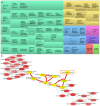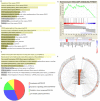Indoxyl Sulfate Induces Apoptosis Through Oxidative Stress and Mitogen-Activated Protein Kinase Signaling Pathway Inhibition in Human Astrocytes
- PMID: 30764571
- PMCID: PMC6406290
- DOI: 10.3390/jcm8020191
Indoxyl Sulfate Induces Apoptosis Through Oxidative Stress and Mitogen-Activated Protein Kinase Signaling Pathway Inhibition in Human Astrocytes
Abstract
Uremic toxins accumulated in chronic kidney disease (CKD) increases the risk of cognitive impairment. Indoxyl sulfate (IS) is a well-known protein-bound uremic toxin that is correlated with several systemic diseases, but no studies on human brain cells are available. We investigated the effect of IS on primary human astrocytes through next-generation sequencing and cell experiment confirmation to explore the mechanism of IS-associated brain damage. Total RNAs extracted from IS-treated and control astrocytes were evaluated by performing functional and pathway enrichment analysis. The toxicities of IS in the astrocytes were investigated in terms of cell viability through flow cytometry; the signal pathway was then investigated through immunoblotting. IS stimulated the release of reactive oxygen species, increased nuclear factor (erythroid-derived 2)-like 2 levels, and reduced mitochondrial membrane potential. IS triggered astrocyte apoptosis by inhibiting the mitogen-activated protein kinase (MAPK) pathway, including extracellular-signal-regulated kinase (ERK), MAPK/ERK kinase, c-Jun N-terminal kinase, and p38. The decreased ERK phosphorylation was mediated by the upregulated dual-specificity phosphatase 1, 5, 8, and 16. In conclusion, IS can induce neurotoxicity in patients with CKD and the pathogenesis involves cell apoptosis through oxidative stress induction and MAPK pathway inhibition in human astrocytes.
Keywords: astrocyte; dual specific phosphatase; indoxyl sulfate; mitogen-activated protein kinase; oxidative stress; uremic toxins.
Conflict of interest statement
The authors declare no conflict of interest.
Figures










Similar articles
-
Indoxyl sulfate upregulates the cannabinoid type 1 receptor gene via an ATF3/c-Jun complex-mediated signaling pathway in the model of uremic cardiomyopathy.Int J Cardiol. 2018 Feb 1;252:128-135. doi: 10.1016/j.ijcard.2017.11.086. Epub 2017 Dec 2. Int J Cardiol. 2018. PMID: 29203210
-
Indoxyl sulfate induces oxidative stress and hypertrophy in cardiomyocytes by inhibiting the AMPK/UCP2 signaling pathway.Toxicol Lett. 2015 Apr 16;234(2):110-9. doi: 10.1016/j.toxlet.2015.01.021. Epub 2015 Feb 19. Toxicol Lett. 2015. PMID: 25703824
-
Indoxyl sulfate induces apoptotic cell death by inhibiting glycolysis in human astrocytes.Kidney Res Clin Pract. 2024 Nov;43(6):774-784. doi: 10.23876/j.krcp.23.005. Epub 2023 Aug 10. Kidney Res Clin Pract. 2024. PMID: 37956994 Free PMC article.
-
The influence of uremic toxins on low bone turnover disease in chronic kidney disease.Tzu Chi Med J. 2023 Dec 13;36(1):38-45. doi: 10.4103/tcmj.tcmj_212_23. eCollection 2024 Jan-Mar. Tzu Chi Med J. 2023. PMID: 38406573 Free PMC article. Review.
-
Human Protein Kinases and Obesity.Adv Exp Med Biol. 2017;960:111-134. doi: 10.1007/978-3-319-48382-5_5. Adv Exp Med Biol. 2017. PMID: 28585197 Review.
Cited by
-
The role of neuroimmune and inflammation in pediatric uremia-induced neuropathy.Front Immunol. 2022 Sep 15;13:1013562. doi: 10.3389/fimmu.2022.1013562. eCollection 2022. Front Immunol. 2022. PMID: 36189322 Free PMC article. Review.
-
Klotho downregulation contributes to myocardial damage of cardiorenal syndrome in sepsis.Mol Med Rep. 2020 Aug;22(2):1035-1043. doi: 10.3892/mmr.2020.11178. Epub 2020 May 22. Mol Med Rep. 2020. PMID: 32468073 Free PMC article.
-
Pro-Inflammatory Effects of Indoxyl Sulfate in Mice: Impairment of Intestinal Homeostasis and Immune Response.Int J Mol Sci. 2021 Jan 24;22(3):1135. doi: 10.3390/ijms22031135. Int J Mol Sci. 2021. PMID: 33498967 Free PMC article.
-
Diverse roles of microbial indole compounds in eukaryotic systems.Biol Rev Camb Philos Soc. 2021 Dec;96(6):2522-2545. doi: 10.1111/brv.12765. Epub 2021 Jun 17. Biol Rev Camb Philos Soc. 2021. PMID: 34137156 Free PMC article. Review.
-
Chronic kidney disease and neurological disorders: are uraemic toxins the missing piece of the puzzle?Nephrol Dial Transplant. 2021 Dec 28;37(Suppl 2):ii33-ii44. doi: 10.1093/ndt/gfab223. Nephrol Dial Transplant. 2021. PMID: 34718753 Free PMC article. Review.
References
-
- O’Lone E., Connors M., Masson P., Wu S., Kelly P.J., Gillespie D., Parker D., Whiteley W., Strippoli G.F., Palmer S.C., et al. Cognition in People with End-Stage Kidney Disease Treated with Hemodialysis: A Systematic Review and Meta-analysis. Am. J. Kidney Dis. 2016;67:925–935. doi: 10.1053/j.ajkd.2015.12.028. - DOI - PubMed
Grants and funding
LinkOut - more resources
Full Text Sources
Research Materials
Miscellaneous

